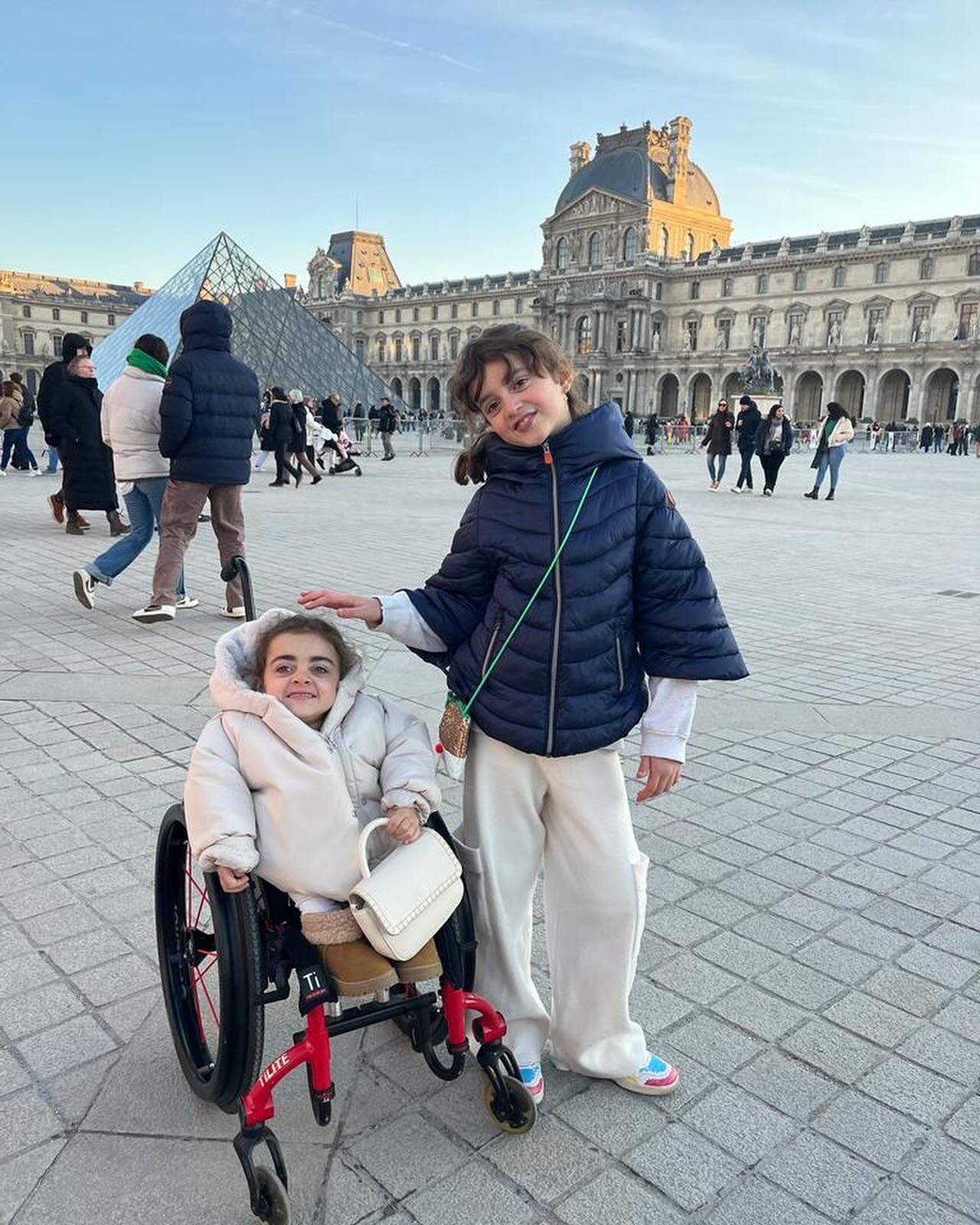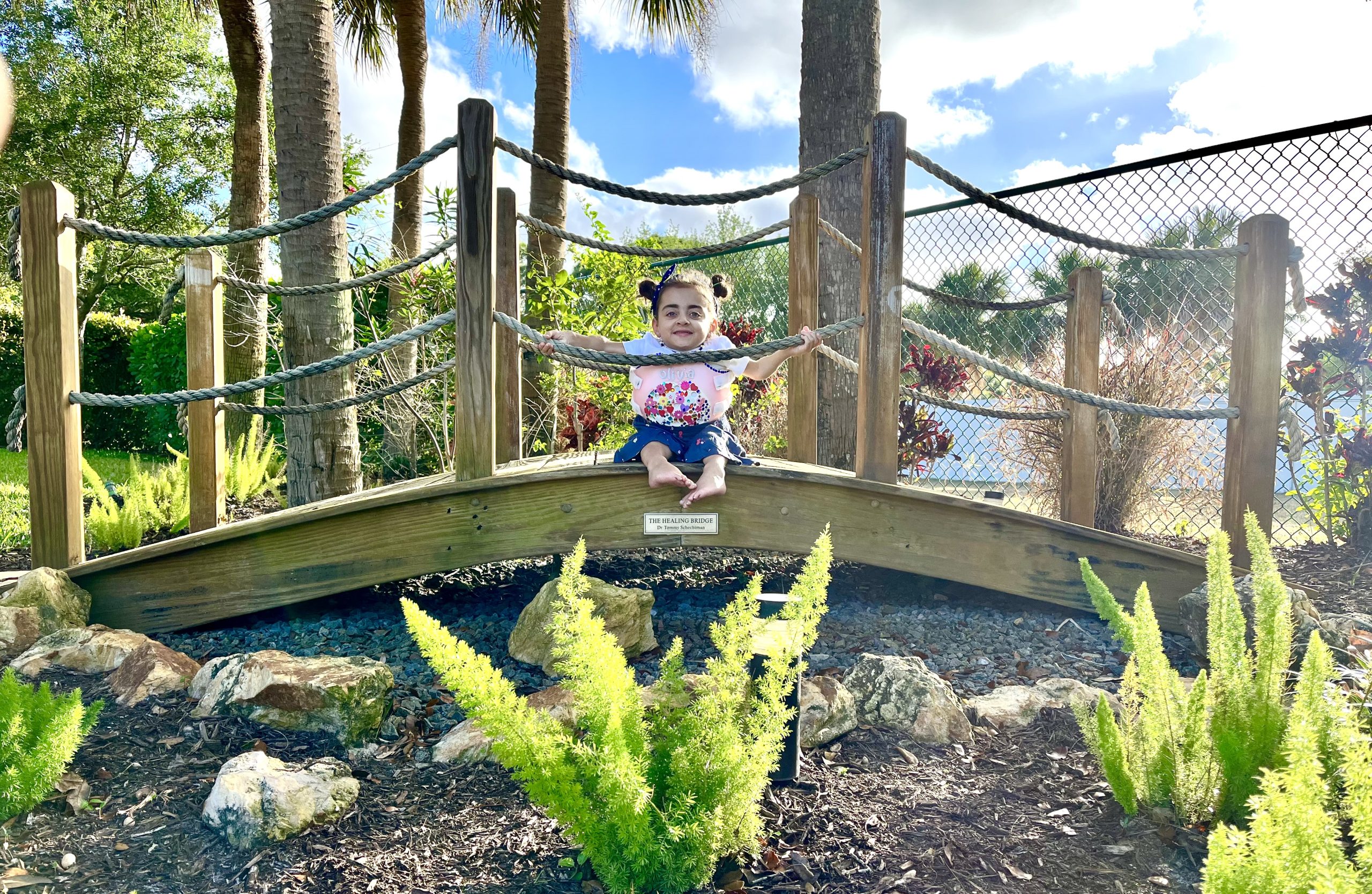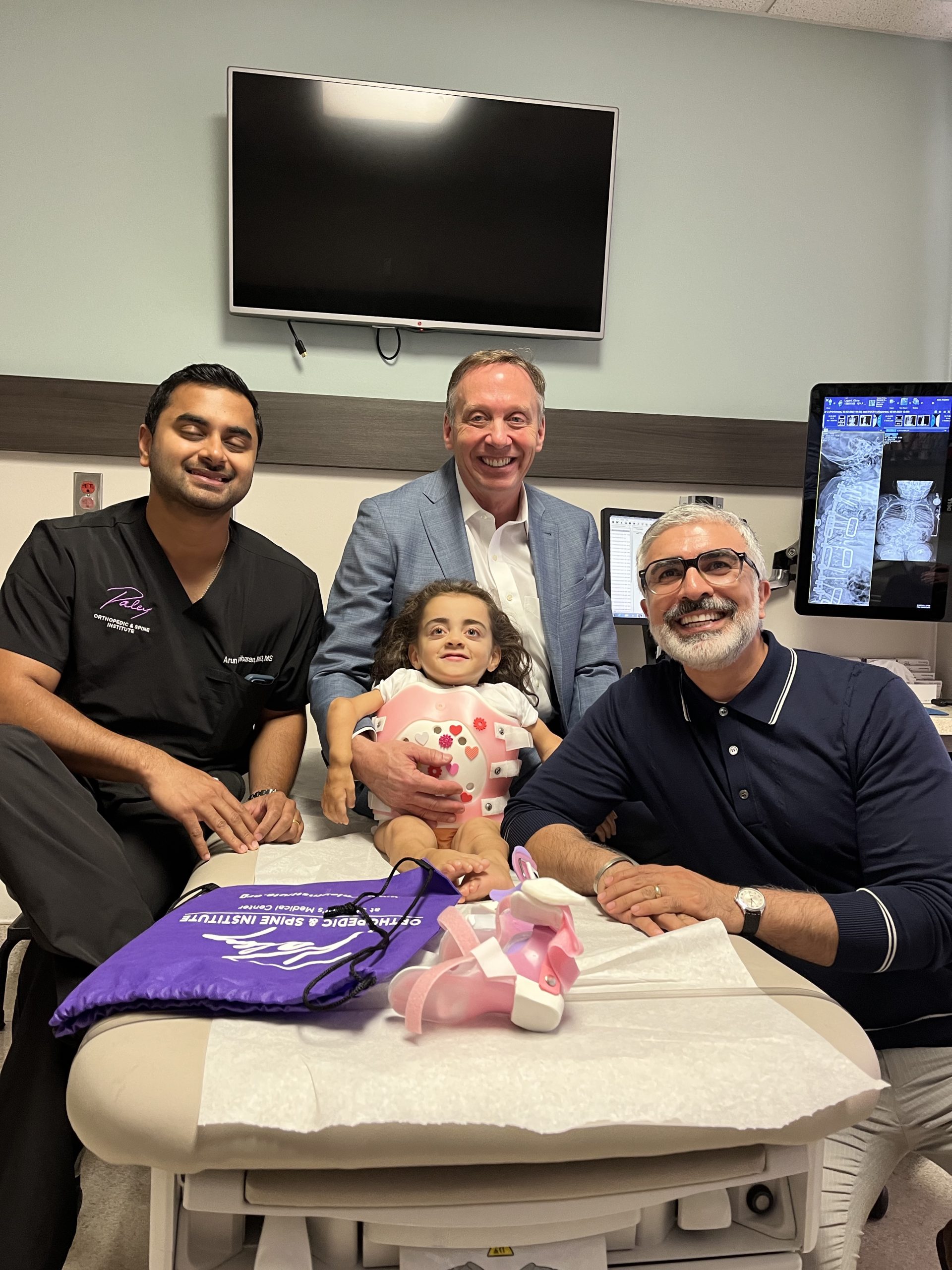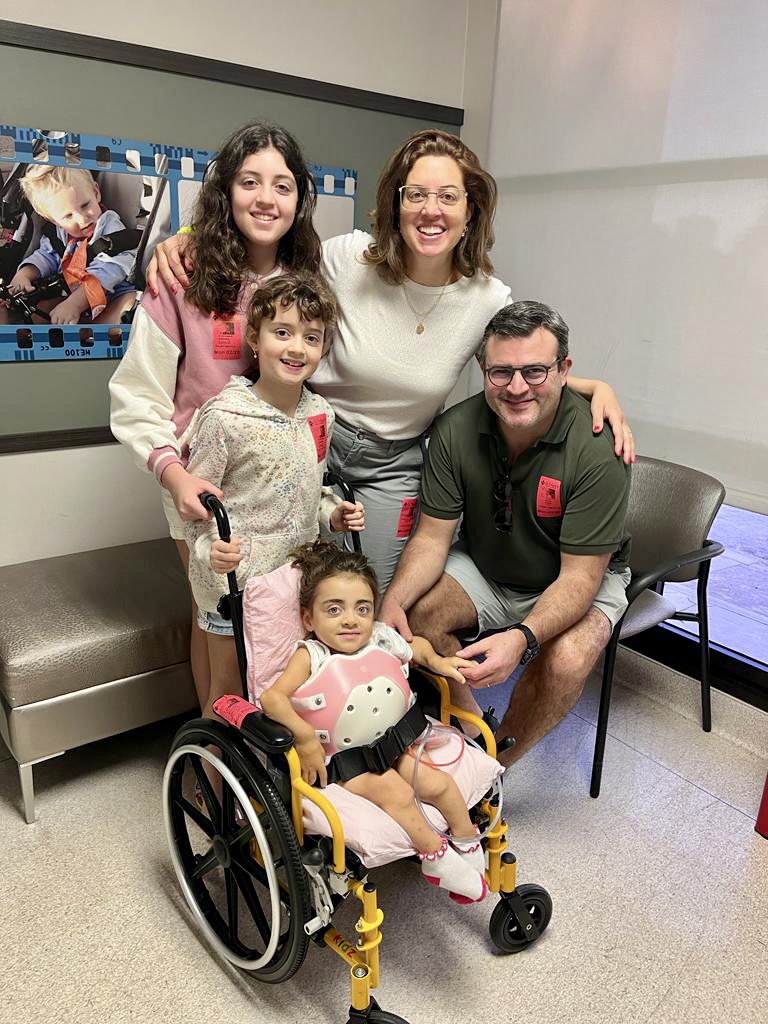I was asked by Professor Sahar Mansour at St. George’s University Hospital, London, to speak to 20 biomedical students on January 23, 2018 to discuss the difficulties Olivia has faced as a child with a rare disease. How has she approached these issues, how have they affected the family, and what are the limitations of dealing with such a rare condition? This is my story.
My daughter Olivia (O) is 5 years old and has a life-limiting condition. It is an extremely rare form of Dwarfism, called Goldblatt Syndrome. O is the 18th child diagnosed with this condition worldwide.
Symptoms include extreme short stature, joint laxity, scoliosis, flattened vertebrae, hypermobility, neck instability, low muscle tone, narrow chest cavity, and weak tooth enamel called DI-Dentinogenesis Imperfecta. She cannot walk independently due to her spinal curvature and disproportionate head-to-body size. Her current weight is 10kg and height has remained at 67cm since the age of 10 months.
Olivia was born at 38 weeks by normal delivery. Birth weight was 2.73kg. At the age of 4 months we began to recognize that O was shorter than her peers and her older sister who was in the 90th percentile for growth. We noticed she was slow to lift and pivot her head. She screamed whenever she was put onto her stomach for tummy time and had weak truncal tone. At 8 or 9 months O was sitting unaided, but was very reluctant to stand on her legs and bear weight. She could not roll over or crawl. It was at this point I began to seek answers from our GP and Pediatrician. However, no one would listen to my concerns, stating ‘every child develops differently.’ It was only after visiting a family doctor in France when we were advised to seek genetic testing, as OL was considerably below any of her growth milestones, well below the 0.4 curve on the growth chart in the red book.
In preparation for this talk today, I reread several clinical letters that reminded me of a very difficult time in our journey of finding a diagnosis. We were told our daughter’s urine analysis tested positive for Morquio syndrome, a possibly fatal lysosomal-deficiency. Thankfully, this test was repeated and results were negative. Although O presented as having Morquio, it was only through radiographic images that retired doctor Christine Hall of Sheffield Hospital, confirmed a clinical diagnosis of Goldblatt Syndrome. In 2015, genetic testing of the Goldblatt Syndrome gene at the University of Lausanne in Switzerland was negative, highlighting a possibility of a mutation of the gene. The doctors there did not perform any further tests. As rare as the disease may be, autosomal recessive transmission is likely. In 2016, DNA samples were submitted for the DDD Study and the 100,000-genome test, results of which are immanent
From O’s age of 9 months, I have been on an endless pursuit chasing consultant’s opinions from around the world. With the advice from family and friends and Google, of course, specialists with expertise in skeletal dysplasia would pop up and I would spend my days contacting them, begging for help. What can they do to help my daughter? What does the future hold? Have they ever met a child with Goldblatt Syndrome? Will O ever walk independently? We tried to find reassurance by meeting with Dr Wilcox at Emory University in Atlanta, Dr McKensie at Nemours in Philadelphia, Dr Bruckheimer at University of Utah, Dr Danielpour at Cedars Sinai in Los Angeles, and Prof. Zerah at Necker in Paris. All they offered was false hope and extreme anxiety.
In the beginning, I found bonding with O very difficult. I treated her as a fragile baby, fearful of doctors’ assessments and unable to accept that she was ‘different.’ This caused me and the family incredible stress. O underwent endless investigations with no clear outcome. I was on an endless pursuit of trying to fix her. It was at this time I feel psychological support would have been essential to help us come to terms with the reality of having a child with an extremely rare disease. We were never given any help with O’s day-to-day challenges or given any reassurance of what the future would bring. I had to do research and bang on doors myself, which forced me to give up my investment banking job and focus all my attention and energy on O without giving any notice to my eldest daughter or my own needs. The number of professionals involved was reaching 20, but no one ever offered to put an infrastructure in place to facilitate communication. There is a Chinese Wall between the hospitals and the local team that is very difficult to break down.
Now, after 5 years of an exhaustive search, I am now carefully selecting a team of doctors across various London hospitals to have a holistic view of O’s complex needs. My reason for sticking to our home turf is due to the advice given by close friends in the medical field who said we had to trust the local team around O. I could not continue to chase opinions from all over the world, from doctors who had never met O. I was running on a hamster wheel; feeling anxious, depressed, and utterly lost. I realize that by compiling so many different opinions I was putting myself, a non-medical professional, in the middle.
Due to the rareness of Goldblatt Syndrome, there is a lack of knowledge or expertise available to foresee O’s future and it is extremely difficult to unify the differences. Some children have completely unique presentation. It’s my tenacity that has carried me through these dark, uncertain days to find the silver lining. I am now shifting from an endless pursuit of unanswerable questions, to creating a loving environment for O to optimize her quality of life. As she is growing older and more aware of her physical differences, the psychological impact is an important factor. Unlike her physical challenges, the psychological impact can be managed. Through the help of my therapist, my journey of acceptance became more clearly visible. I slowly began my journey to shine a light on all of O’s positive attributes, rather than focusing on all the negative ones. Medicine is not an exact science and we know there is no cure for her condition, so we live life day by day.
I challenge people everyday to think outside the box. Rarely can anything for O be acquired off the shelf. Whether it’s her school uniform, walking shoes, toileting facilities, or the numerous pieces of equipment that offer mobility and access to her environment at home and school. Most things have to be specially made. For example, a company called Quest88 who never built a walker to suit an individual client’s bespoke needs, agreed to construct one for O. Theraplay is another company currently undergoing research to shorten the pedal distance on a tricycle from 32cm to 25cm to suit O’s short legs. Permobil adapted her Koala wheelchair to suit their ‘smallest client.’ The pediatric toilet at school was too high for her to reach, so I sourced a carpenter to build steps with handlebars for her to climb up without assistance. The NHS did not supply nor guide me on sourcing any of this equipment.
O has numerous hospital appointments every month; therefore I must ensure that if they are not altering the management of her care, I suggest a phone consultation. I have now developed a strong voice and decline attendance, as this puts too much pressure on me to reorganize the daily schedule, causes O anxiety to be in a clinical setting, and removes her from important social interactions at home and school.
Due to O’s cervical instability, the top neurosurgeon at Great Ormond Street Hospital (GOS), Mr. Dominic Thompson, is currently seeking professional advice outside of his field, namely Respiratory, Anesthesiology, Endocrinology, Pediatrics, and Genetics, to assess the risks with performing a cervical fixation. The effect of surgery on O’s respiratory system is life threatening. There are currently 21 medical professionals under O’s care and they are all unsure whether O’s small body can withstand an invasive surgery. They are trying to make decisions in a field of complete uncertainty. Her bones are so small, do they have the appropriate tools and equipment to fuse her neck, and will the surgery be successful? If attempting to fix the instability in the first and second vertebrae will lessen her quality of life by restricting her movement and possibly resulting in spinal cord damage or a life-long need of a respirator, then we must wait until there is a clinical need to intervene. The pros and cons must be weighed from all medical fields to make the best decision.
One of the most difficult struggles I have faced with the medical community is the lack of communication amongst the doctors themselves and with me, the parent. My daily life involves endlessly chasing professionals via email and phone to follow-up appointments, receiving test results, or confirming clinic dates. I have been shut out of important discussions, not made aware of test results in a timely fashion, and given countless inaccurate timescales. All of these things cause a lot of stress and do not allow me to enjoy my daily life as a mum. There has never been a Lead Pediatrician appointed to link up the over 21 professionals. That is me. After 4 years of persistent requests for professionals to discuss O’s care holistically, finally, doctors at St George’s, Evelina and GOS, are now coming together for multi-disciplinary meetings to discuss her future care plan.
O has a huge personality. Those who meet her love her instantaneously. At times, you notice eyes staring at her because they don’t understand how someone so small can speak so eloquently! I make sure when people meet her for the first time they speak to her like a 5 year old, not like the baby she may seem to be. I fight for O’s inclusion in society everyday. It took over 12 months to convince the local council that O needed full-time 1:1 assistance in a mainstream school setting to ensure her physical safety and access the curriculum. I strive everyday to help O develop a strong self-esteem and offer her as much independence as possible. She is now able to dress herself, which makes her feel like she’s accomplished something without mommy’s help. I feel it is my motherly duty to facilitate the understanding of others so she is treated like any other 5 year old. When she started nursery and later for Reception, I wrote a letter to the parents introducing them to Olivia, explaining her condition and how they should treat her. Thankfully, O is a very bright child. It is very rare to have a child with physical disability and strong cognition. Her passions include reading Roahl Dahl and Doctor Seuss books, creating science experiments, constructing Lego displays, coding on her computer, and singing and dancing.
Recently, I launched a website called olivialugani.com in order to raise awareness and open up the world to what life is like for O and the family. She has 2 sisters who absolutely adore her and the girls cherish playing together. In 2014, we decided we wanted to have a 3rd child, knowing there was a 25% risk of her having Goldblatt Syndrome, but my husband and I felt strong enough to handle whatever God brought our way. We now tell Olivia she is sandwiched in-between, as she has the life-long support of an older and younger sibling.
In 2017, I held a fundraiser to raise money for O’s privately purchased £20,000 electric wheelchair, which opened many doors. The Permobil Koala wheelchair has been an amazing contribution towards her endless desire of independence. She now has use of her legs! Capturing her beaming smile on the playground and at the park genuinely warms your heart. She is a very endearing child, but quite determined as well. Like her mother she will never take no for an answer. I’m one proud mama!
Through my pursuit of raising awareness, I received messages from parents facing the uncertainty of their child’s condition. This has given me great strength in knowing I can help. The local community has also been very supportive. They recognize Olivia and say hello as she passes them in her wheelchair. Fundraising has been broadened by people approaching me to run races, as a means to raise money for O’s costly, non-NHS funded equipment needs. The upcoming Royal Parks 10k race on Jan 28 in Hyde Park has 12 participants running for O! Charities have also been very supportive. For example, Make-A-Wish installed a hot tub to soothe Olivia’s aching muscles last summer, which was a fantastic contribution. WhizzKids, Newlife, Variety all made contributions towards O’s wheelchair. A good friend of the family recently published an article on The Huffington Post, which eloquently depicts our journey. I now use social media to raise awareness and promote fundraising initiatives. I have also teamed up with Facebook and Instagram personalities to promote O’s @sparkling_tiaras brand. Further information can be found on O’s website.
We know Olivia has an uncertain future, but the one thing we are sure of is she will be a world-changer ‘cause she’s a #Girlinabillion.
Thank you for listening to my story
Stephanie Lugani
Take-away’s
There is lack of infrastructure around the child and family in coping with a rare disease
Importance of listening to the parent. We are the experts who know the child’s needs best.
Importance of having a holistic view of the child. Not just looking at them through a telescope.
Lack of Lead Professional to manage the abundance of medical professionals involved.
The more rare the condition, the harder it is to unify the differences. Some children have completely unique presentation.
Recognising the child’s vulnerability and anxiety towards entering a clinical setting.
The pros and cons must be weighed from all medical fields to make the best decision.
Please view this 23 min video of “Olivia in Action.” It will warm your heart.







Bonsoir,je suis partie de votre annonce pour une nounou et a atteri sur cette page qui m’a enormement touchée…Je suis une ex nounou qui vient d’être maman il y a 7 mois et je ne peux que vous dire un enorme bravo pour votre combat et votre fille a bcp de chance d’avoir une maman”guerriere” aussi forte et determinee car ce n’est pas facile dans ce monde de se faire entendre et comprendre.J’aurais bcp aimé vous aider et partager le quotidien d’Olivia mais 4 filles ca ferait bcp à gerer pour moi seule :-).
Je vous souhaite bcp de courage et de reussite dans votre futur car vous le meritez enormement!Un bisou pour la petite Olivia qui est trop mignonne!